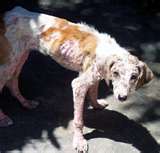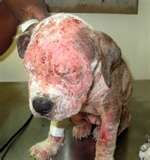Ringworm in Dogs
What most owners do not understand is that this has absolutely nothing to do with worms
Ringworm in dogs is an extremely contagious skin infection as well as zoonotic, meaning that it can very easily be spread from dogs to humans.
However, there is one very large misconception about this disease; it is not caused by a worm.
Instead, it is caused by fungi infection and there are several different fungi that are found worldwide.
CAN BE EXTREMELY FRUSTRATING
In this case, it is most often caused by a fungi referred to as Microsporum canis.
There is also another very unique characteristic about this infection; it can be the most frustrating experience you will ever have as an owner, as well as one of the most expensive.
Although this infection is not very common in healthy dogs, it can very easily affect younger dogs that have not built a strong immune system.
However, it can affect any dog that has any type of a weakened immune system.
There are other conditions that can also lead to ringworm.
Tse include any type of a pre-existing skin condition that your dog may have, as well as some type of a recent trauma that affects their system.
If your dog is on any type of medication that may suppress their immune system in any way, they are also at a much higher risk of contracting this very contagious skin infection.
But the list does not end there, as dogs that are in any type of a shelter or kennel are also at a higher degree of risk.
Dogs that are stressed or are not receiving the proper nutrition in their diets are also at risk.
WHERE RINGWORM IN DOGS IS FOUND
 Ringworm in dogs can be extremely challenging
Ringworm in dogs can be extremely challengingRingworm in dogs in most all cases attacks your dog’s head, but they can also attack their legs, feet, and tail.
If this infection spreads to humans, it centers on the scalp, the entire body, as well as the nails. Ringworm can very easily spread from person to person, from your dog to you, as well as indirectly.
If your dog comes into contact with an object or soil that has been contaminated, this can also lead to infection.
Ringworm fungus is much more common in hot and very humid environments, but it can also be found in most environments.
There is also one other very interesting fact about this fungus; when it does attack your dog; it is usually in the fall or the winter months, not in the summer.
The fungi itself is usually found very near or on your dog’s living quarters, even if they are an indoor dog.
However, there is still another very large challenge with ringworm in dogs; the lifespan of the spores.
These spores will actually spend very little time on your dog as they are shed quite easily, but by this time the damage has been done.
But once they are shed, they can still live in the environment and remain contagious for 18 to 24 months in some cases.
HOW IT IS TRANSMITTED
Ringworm in dogs are very easily transmitted by coming into contact with another dog that is infected, or simply brushing against any type of an item that has the spores of this fungi still alive.
The spores may have long since shed from an infected dog.
But because of their strength, they can easily lay in the soil just waiting to attack their next target, in this case your dog.
Ringworm in dogs is very easily be transmitted by any type of a grooming tool.
This is especially true if your dog has come from a shelter, or is placed in a kennel with a dog that may be infected and that tool is shared.
But the risk does not end just with dogs, as this highly contagious skin condition also affects cats.
If you have an infected cat in your household, or your dog accidentally comes into contact with an infected cat, this can also cause infection.
Symptoms
Ringworm in dogs will show you some very distinctive symptoms with the first being scaly and inflamed skin.
Once you see this first sign, it can very easily be confused with mange, until you look at it closely.
Once you do, you will see the symptoms that are very characteristic with this skin infection; small round lesions.
The lesions will quickly affect your dog hair causing hair loss in the lesion, and they will also have very scaly skin in the center of the lesion as well as small pustules.
However, what truly identifies it as ringworm is how it grows.
These lesions usually start out very small and they almost always will grow in sizes as it intensifies. However, there is another characteristic with ringworm; they may or may not be itchy.
This infection will usually affect your dog’s head, but it the infection is severe enough, it can also affect their legs, feet, as well as their tail.
This skin infection may be very mild in a strong and healthy dog, or it can be very severe if your dog is not at full health.
TREATMENTS CAN BE VERY EXPENSIVE
Ringworm in dogs can be one of the most frustrating experiences you will ever have as an owner, as well as one of the most expensive, especially if you are in a multi-pet household.
In mild cases, the ringworm infection will resolve itself over time.
However it is still recommended to have it treated as it helps to speed up the cure as well as reduce further contamination.
There are vaccines for ringworm in dogs, but they are only used as additional treatments, not as a preventive measure.
If the lesion is isolated, the area around the lesion is thoroughly clipped down very close to your dog’s skin.
This has to be done by your veterinarian and should never be attempted on your own, simply because if you irritate the skin in any way, it can cause the infection to spread.
Once this is done, the lesion will be treated with an anti-fungal treatment twice a day by topical solutions such as Miconazole or Lotrimin cream, as well as a one percent chlorhexidine ointment.

If the infection is considered to be severe and is generalized on your dog’s skin, anti-fungal shampoo’s or dips may be used.
There are several medicated shampoos that your veterinarian may use, as well as lime dips, but again this is something that has to be done by a professional.
These treatments are usually given every 2 to 4 days until the infection is resolved. Home cleaning is also extremely important, as this is a very difficult fungi spore to kill.
In most cases, it is in the best interest of both you and your dog to throw away anything disposable.
Than you will have to wash their bedding in a sodium hypochlorite solution, which is quite easy, as you simply take bleach and dilute it to 1:20 ratio with water.
Summary
Ringworm in dogs is extremely contagious, as it can and does spread to humans as well as other pets.
It is also very frustrating in that it can reoccur several weeks or months after you have had the treatments, and you may have to repeat the process all over again.
Pet Medications for Ringworm in Dogs
Dog Vitamin Store
Canine Infectious Hepatitis








